Reposted by permission from: SEAFOODNEWS.COM [Newsweek] By Megan Scudellari – October 2, 2014
 Photo Credit: WordPress – Dive.Roko
Photo Credit: WordPress – Dive.Roko
A grisly horror show is playing out along the West Coast of North America. Remains of millions of dead and dying sea stars, commonly known as starfish, litter the shoreline from Vancouver to San Diego.
Those stars are the victims of a swift and brutal illness. First, the animal’s body deflates, as if drained of all its water. Then the trademark arms begin to curl, detaching from rocks. White lesions appear, like festering canker sores. Then the star explodes as organs rupture though the body wall. The arms fall off. Ultimately, the sea star dissolves, as if melted by acid, disintegrating into goo.
Researchers in Washington state first noticed signs of the so-called “wasting syndrome” in June 2013 during routine monitoring of populations of bright purple and orange Pisaster ochraceus sea stars. The outbreak continued through the summer, spreading down into California’s central and southern coasts. Scientists hoped it would subside during the winter. It did not.
This summer, the outbreak morphed into a full-scale epidemic: Dead stars, of over 20 species, can now be found from Mexico all the way up to Alaska. It’s hard to find even a single group of stars that isn’t affected, says professor Drew Harvell of Cornell University, who spent the last year tracking the outbreak around the San Juan Islands near Seattle. The die-off is so bad that researchers have lost count of how many stars are lost. They estimate millions.
“It’s the largest epidemic we’ve ever seen with marine wildlife,” says Harvell. “We watched our populations go from thousands of stars to none over the space of a month.” The wasting syndrome has also been reported in populations along the East Coast, from New Jersey to Maine, though fewer monitoring programs exist there to quantify its spread.
Sea stars are voracious predators at the top of the coastal food chain, key members of the environment that chomp away on mussels, barnacles and more. Without sea stars, food webs are being upended: In Howe Sound, northwest of Vancouver, for example, green sea urchins, one of the sea stars’ prey, are flourishing and devouring large amounts of seaweed, once home to young spot prawns. The prawns used the seaweed as a nursery; without it, young prawns cannot flourish. And shorelines that used to be dotted with sea stars and other species are now blanketed with barnacles growing with abandon, a sign of the loss of biodiversity on the coast.
No one yet knows the exact causes of the epidemic. Some evidence suggests the outbreak is linked to warming ocean temperatures or other changes in the ocean due to climate change. It wouldn’t be the first time: Climate-related disease spread has been documented in corals and shellfish, although on a smaller scale than sea star wasting syndrome. This may be because infectious microorganisms thrive in warmer temperatures. Last year, for example, scientists found that ocean warming is promoting the growth and persistence of pathogenic bacteria in the North Sea in Europe.
Bruce Menge, an ocean ecologist at Oregon State University, has been studying sea stars along the Oregon coast for over 30 years. Now, at some of his study sites, he can no longer find even a single star. “Deep down, I worry this might be a harbinger of some impending, major problem resulting from climate change,” Menge says. “If what we’re seeing in this marine environment is any indication of what we might see in the future,” he adds, “it could lead to a complete alteration of coastal ecosystems,” ultimately affecting fish populations and the people that rely on them.
On the other hand, the death of captive sea stars in aquariums in both Seattle and Vancouver—in tanks that had maintained healthy populations for 40 years—suggests the cause is an infectious microorganism able to travel through water. Aquariums maintain constant temperatures in their tanks but fill them with circulating ocean water, so perhaps something in the water made the captive stars sick.
A team of eight pathologists, led by Alisa Newton of the Wildlife Conservation Society, closely examined slides of tissues harvested from dead or dying sea stars from both aquariums and the wild. “We haven’t seen, on slides, any parasite or fungus or specific organisms in the tissues,” Newton says. However, that rules out only infectious agents that are large enough to be seen with a light microscope.
To try to detect smaller microorganisms, Ian Hewson of Cornell, one of the few scientists in the world specializing in viruses that infect marine invertebrates, sequenced the DNA of hundreds of sea star samples to look for genetic evidence of a virus or small bacteria. He has recently found “quite conclusive” evidence for the involvement of at least one virus or bacteria, Harvell says, but until other scientists review that research, the Cornell team is declining to reveal the identity of the culprit.
Still, even if a virus or bacterium is implicated, Newton, Harvell and others agree the extent of the current wasting syndrome is most likely the result of multiple factors. Harvell’s team, for instance, detected a correlation between sea star deaths and warmer waters, so she and her team took sea stars into the lab, where they could control the environment, and found that the stars deteriorated faster at warmer temperatures. If warmer temperatures increase the speed or spread of the disease, that doesn’t bode well for the coming months: The National Oceanic and Atmospheric Administration is predicting that El Niño, a period of unusually warm sea surface temperatures in the Pacific, is likely to begin this fall and run into the winter.
On the flip side, the wasting syndrome appeared on the Oregon coast at the same time that deep, cold water rose up and filled the area, says Menge, so perhaps it is not warming waters but other effects of climate change, such as ocean acidification or lack of oxygen in the water, that led to the outbreak.
Either way, if the epidemic was exacerbated by climate change, similar widespread illnesses in other marine life may soon occur. Sea stars are, in a way, the canary in the coal mine of the ocean. “Honestly, if this had been a small worm or small crab, the whole thing could have happened and we never would have even known about it,” says Harvell. “Epidemics in the ocean are definitely out of sight and out of mind. As it was, it took a while for us to understand the scale of this.” Now, though, awareness is growing. In mid-September, for example, Rep. Denny Heck, D-Washington, introduced the Marine Disease Emergency Act to Congress,with the goal of creating a national response strategy to sea star wasting syndrome and future marine disease emergencies.
At the University of California, Santa Cruz, professor Pete Raimondi and his colleagues have been assessing the impact of the loss of the sea stars. They continue to monitor coastal areas to see if the absence of this top predator will cause predicted effects, such as increasing mussel populations and a loss of biodiversity. If so, that doesn’t bode well for the ecosystem.
But recently, Raimondi’s team saw small twinkles of hope dotting the rocky shore. Little juvenile stars, about the size of a thumbnail, are latching on to the coastline. Raimondi doesn’t know yet if these babies are susceptible to the disease. If they are, the new sea stars won’t live long enough to breed, and sea star populations may not recover next year. “This year might be the best, last chance for the animals,” says Menge.
But if the young stars are resistant to the epidemic and survive, there is hope—both for the stars and the ecosystems in which they live. “We should know in the next six months,” Raimondi says. “We’re tracking them. We’ll see whether the little guys grow.”

Ken Coons
SeafoodNews.com 1-781-861-1441
Email comments to kencoons@seafood.com
Copyright © 2014 Seafoodnews.com
 The Greenpeace Dual Deep Diver.
The Greenpeace Dual Deep Diver.


 By
By 











